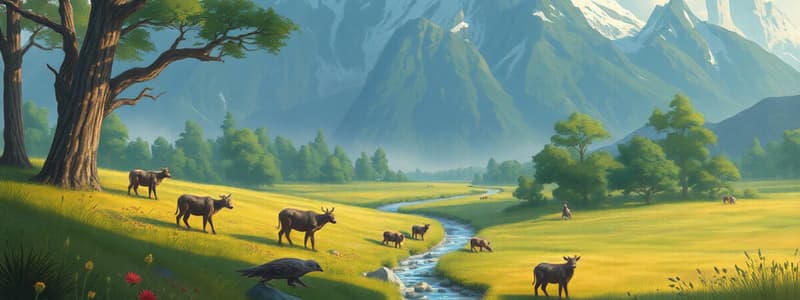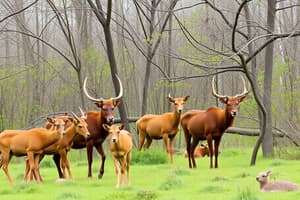Podcast
Questions and Answers
What does the population growth formula G = B + I - D - E represent?
What does the population growth formula G = B + I - D - E represent?
- Species competition
- Births, Immigration, Deaths, Emigration (correct)
- Population dynamics
- Natural resource depletion
Carrying capacity refers to the maximum population size that an environment can sustain indefinitely without being degraded.
Carrying capacity refers to the maximum population size that an environment can sustain indefinitely without being degraded.
True (A)
What is demography?
What is demography?
The study of statistics related to births and deaths within populations.
In predator-prey dynamics, predators regulate the prey population and vice versa, resulting in population ______.
In predator-prey dynamics, predators regulate the prey population and vice versa, resulting in population ______.
Match the following terms in population ecology with their definitions:
Match the following terms in population ecology with their definitions:
Which factor is NOT a regulating factor of population growth?
Which factor is NOT a regulating factor of population growth?
Urban sprawl has no significant effect on habitat destruction.
Urban sprawl has no significant effect on habitat destruction.
What are the primary resources affected by human consumption mentioned in the study?
What are the primary resources affected by human consumption mentioned in the study?
What does the term 'carrying capacity' refer to in population ecology?
What does the term 'carrying capacity' refer to in population ecology?
Which of the following factors is essential for understanding population growth limitations?
Which of the following factors is essential for understanding population growth limitations?
What is demography primarily concerned with?
What is demography primarily concerned with?
How do predators influence prey population dynamics?
How do predators influence prey population dynamics?
Which consequence of overpopulation is often seen in urban areas like Mexico City?
Which consequence of overpopulation is often seen in urban areas like Mexico City?
What role does the predator-prey relationship play in population ecology?
What role does the predator-prey relationship play in population ecology?
Which of these factors does NOT contribute to population growth according to the population growth formula?
Which of these factors does NOT contribute to population growth according to the population growth formula?
What effect does urban sprawl have on natural resources?
What effect does urban sprawl have on natural resources?
Flashcards
Population Ecology
Population Ecology
The study of factors influencing population size and composition, which includes births, deaths, immigration, and emigration.
Population Growth Formula
Population Growth Formula
Growth = Births + Immigration - Deaths - Emigration
Carrying Capacity
Carrying Capacity
The maximum number of organisms of a particular species that an environment can support sustainably due to available resources.
Food Chain
Food Chain
Signup and view all the flashcards
Food Web
Food Web
Signup and view all the flashcards
Predator-Prey Relationship
Predator-Prey Relationship
Signup and view all the flashcards
Demography
Demography
Signup and view all the flashcards
Exponential Growth
Exponential Growth
Signup and view all the flashcards
What does population ecology study?
What does population ecology study?
Signup and view all the flashcards
Why is population ecology important?
Why is population ecology important?
Signup and view all the flashcards
What is demography?
What is demography?
Signup and view all the flashcards
What are regulating factors for population growth?
What are regulating factors for population growth?
Signup and view all the flashcards
What is carrying capacity?
What is carrying capacity?
Signup and view all the flashcards
What is a food chain?
What is a food chain?
Signup and view all the flashcards
What is a food web?
What is a food web?
Signup and view all the flashcards
What is the predator-prey relationship?
What is the predator-prey relationship?
Signup and view all the flashcards
Study Notes
Population Ecology
- Population ecology is the study of factors affecting population size and composition, focusing on births, deaths, immigration, and emigration.
- Population ecology is important for understanding human impact on natural resources and for conservation and sustainability efforts.
Key Concepts and Vocabulary
- Demography is the study of statistics related to births and deaths within populations.
- Population growth can be exponential, meaning rapid growth until limited by resources, understanding limitations is important for both human and natural populations.
Factors Affecting Population Growth
- Population Growth Formula: Growth = B + I - D - E (Births (B), Deaths (D), Immigration (I), Emigration (E))
- Regulating Factors: Food and habitat availability, mate availability and competition (both interspecific and intraspecific), disease, predation, and climate factors.
Carrying Capacity
- Carrying capacity is the point at which a population can no longer grow due to limited resources.
Food Chain and Food Web
- Food chains are sequences of energy transfer from producers to apex predators.
- Examples of trophic levels include producers, primary consumers, secondary consumers, etc.
- Food webs are complex networks of interconnected food chains linking species within an ecosystem.
Predator-Prey Dynamics
- Predators regulate prey populations and vice versa.
- Population cycles occur between predator and prey (e.g., lynx and hare).
- Predation affects population growth by contributing to mortality rates.
- Both predators and prey can become linked over time.
- A lab scenario involves beans as prey and students as predators.
Human Impact on Population Ecology
- Human consumption impacts resources: energy (fossil fuels, climate change), water (overdrafting natural springs), and space (urban sprawl leading to habitat destruction).
- Urban areas, like Mexico City, face overpopulation challenges.
Investigation 1: Predator-Prey Relationships
- An experiment involving 100 individuals of each prey species (beans) spread in a 5x5m hunting area.
- Predators have 60 seconds to consume as many prey as possible.
- Predators must consume at least 20 prey items to survive.
- If a predator dies, it becomes the predator species that consumed the most prey in the previous round.
- Before starting the next round, surviving prey reproduce (each surviving bean gains one offspring).
- Carrying capacity for each species is 800 individuals.
Studying That Suits You
Use AI to generate personalized quizzes and flashcards to suit your learning preferences.




